
William Rufus Shafter was a Union Army officer during the American Civil War who received America's highest military decoration, the Medal of Honor, for his actions at the Battle of Fair Oaks. Shafter also played a prominent part as a major general in the Spanish–American War. Fort Shafter, Hawaii, is named for him, as well as the city of Shafter, California and the ghost town of Shafter, Texas. He was nicknamed "Pecos Bill", inspiration for the fictional character of the same name in tall tales.

The Rough Riders was a nickname given to the 1st United States Volunteer Cavalry, one of three such regiments raised in 1898 for the Spanish–American War and the only one to see combat. The United States Army was small, understaffed, and disorganized in comparison to its status during the American Civil War roughly thirty years prior. Following the sinking of USS Maine, President William McKinley needed to muster a strong ground force swiftly, which he did by calling for 125,000 volunteers to assist in the war. The U.S. had gone to war in opposition to Spanish colonial policies in Cuba, which was then torn by a rebellion. The regiment was also nicknamed "Wood's Weary Walkers" for its first commander, Colonel Leonard Wood. This reflected their dissatisfaction that despite being cavalry, they ended up fighting in Cuba as infantry, since their horses were not sent there with them.

The Battle of Marengo was fought on 14 June 1800 between French forces under the First Consul Napoleon Bonaparte and Austrian forces near the city of Alessandria, in Piedmont, Italy. Near the end of the day, the French overcame General Michael von Melas surprise attack, drove the Austrians out of Italy and consolidated Bonaparte's political position in Paris as First Consul of France in the wake of his coup d'état the previous November.
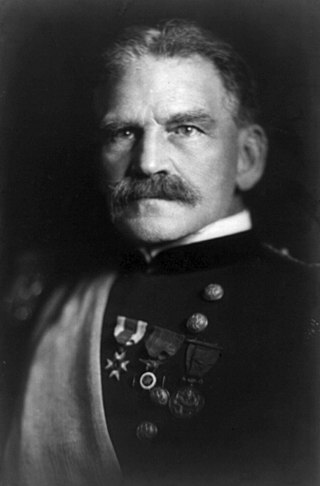
Adna Romanza Chaffee was a lieutenant general in the United States Army. Chaffee took part in the American Civil War and Indian Wars, played a key role in the Spanish–American War, and fought in the Boxer Rebellion in China. He was the Chief of Staff of the United States Army from 1904 to 1906, overseeing far-reaching transformation of organization and doctrine in the army.

Fitzhugh Lee was a Confederate cavalry general in the American Civil War, the 40th Governor of Virginia, diplomat, and United States Army general in the Spanish–American War. He was the son of Sydney Smith Lee, a captain in the Confederate States Navy, and the nephew of Robert E. Lee.
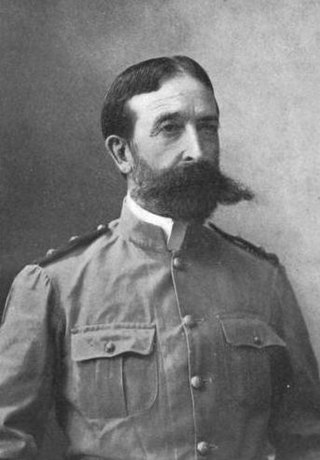
Loyd Wheaton was a United States general who fought in the Philippine–American War and in the Union Army during the American Civil War.
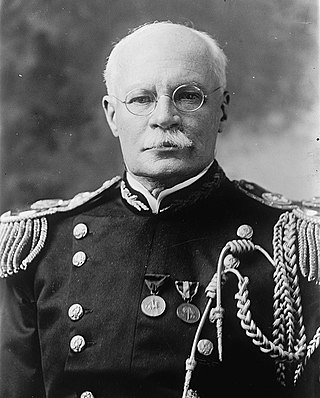
Major General Hugh Lenox Scott was a United States Army officer. A West Point graduate of 1876, he served as superintendent of West Point from 1906 to 1910 and as chief of staff of the United States Army from 1914 to 1917, which included the first few months of American involvement in World War I.
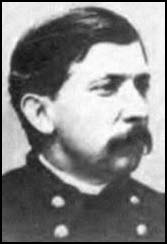
James William Forsyth was a U.S. Army officer and general. He was primarily a Union staff officer during the American Civil War and cavalry regimental commander during the Indian Wars. Forsyth is best known for having commanded the 7th Cavalry at the Wounded Knee Massacre on December 29, 1890 during which more than 250 men, women, and children of the Lakota were killed and more than 50 were wounded.

The area that eventually became the U.S. state of Montana played little direct role in the American Civil War. The closest the Confederate States Army ever came to the area was New Mexico and eastern Kansas, each over a thousand miles away. There was not even an organized territory using "Montana" until the Montana Territory was created on May 26, 1864, three years after the Battle of Fort Sumter. In 1861, the area was divided between the Dakota Territory and the Washington Territory, and in 1863, it was part of the Idaho Territory.

The 1st Oregon Infantry Regiment was an American Civil War era military regiment recruited in Oregon for the Union Army. The regiment was formed in November 1864. At full strength, it was composed of ten companies of foot soldiers. The regiment was used to guard trade routes and escorted immigrant wagon trains from Fort Boise to the Willamette Valley. Its troops were used to pursue and suppress Native American raiders in eastern Oregon and the Idaho Territory. Several detachments accompanied survey parties and built roads in central and southern Oregon. The regiment's last company was mustered out of service in July 1867.

Baron Josef Philipp Vukassovich was a Croatian soldier who joined the army of Habsburg monarchy and fought against both Ottoman Empire and the First French Republic. During the French Revolutionary Wars, he commanded a brigade in the 1796–1797 Italian campaign against Napoleon Bonaparte. He led a division during the Napoleonic Wars and received a fatal wound in action.

Louis Henry Carpenter was a United States Army brigadier general and a recipient of the Medal of Honor for his actions in the American Indian Wars.
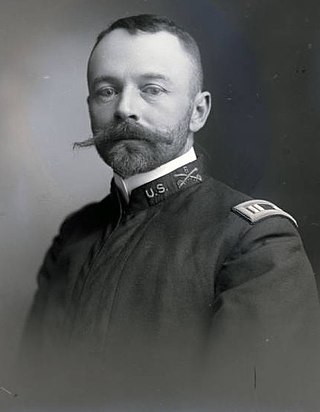
Richard Bolles Paddock (1859–1901) was a United States Army officer, close friend and brother-in-law to John J. Pershing, and one of the few American officers who died while on duty in China during the Boxer Rebellion. Paddock served in the American Southwest during the Apache Wars, as well as the Pine Ridge Campaign (1890–91), the Battle of San Juan Hill (1898) in Cuba during the Spanish–American War, and finally the China Relief Expedition (1900–01). Paddock served as a lieutenant and captain in the 13th Infantry Regiment, the 4th Cavalry Regiment, and the 6th Cavalry Regiment.

Alexander Elisabeth Michel vicomte Digeon, fought in the French Revolutionary Wars in the cavalry. He became a general officer during the Napoleonic Wars, fighting in a number of important battles. After 1814, he gave his loyalty to the Bourbon Restoration and briefly served as Minister of War.
Hispanics in the American Civil War fought on both the Union and Confederate sides of the conflict. Not all the Hispanics who fought in the American Civil War were "Hispanic-Americans", in other words citizens of the United States. Many of them were Spanish subjects or nationals from countries in the Caribbean, Central and South America. Some were born in a US Territory and therefore did not have the right to US Citizenship. It is estimated that approximately 3,500 Hispanics, mostly Mexican-Americans, Puerto Ricans and Cubans living in the United States joined the war: 2,500 for the Confederacy and 1,000 for the Union. This number increased to 10,000 by the end of the war.
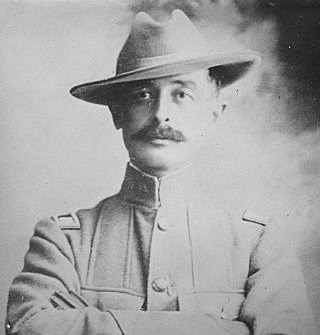
Herbert Jermain Slocum was in charge of the 13th Cavalry Regiment during the Battle of Columbus, New Mexico in 1916 where Pancho Villa burned several buildings in Columbus, New Mexico, stole weapons and horses and killed 18 Americans.
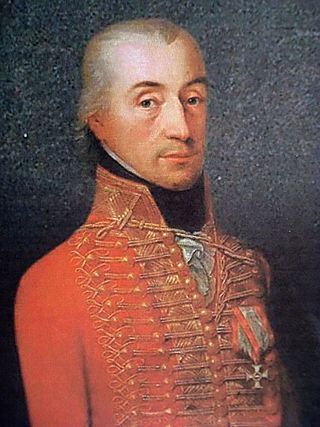
Vinko Knežević or Vincent Knesevich of Saint Helen ; 30 November 1755 – 11 March 1832) was a Croatian nobleman and general in the Habsburg monarchy imperial army service. He was a member of the Knežević noble family. During his long military career he fought in many battles during the Austro-Turkish War and the French Revolutionary Wars. In 1799 he led a hussar regiment at Cassano, the Trebbia and Novi. He commanded an infantry brigade at Marengo the following year and led Austrian Empire troops in the Tyrol in 1805 and at Graz in 1809. He served in various assignments on the Military Border from 1809 to 1812. From 1802 he lived on his estate Sveta Jelena in former Zala County, modern-day Međimurje County in northern Croatia. By the end of Napoleonic Wars he retired from military service as a General der Kavallerie in 1815. He became Proprietor of a dragoon regiment in 1809 and held that office until his death in 1832.
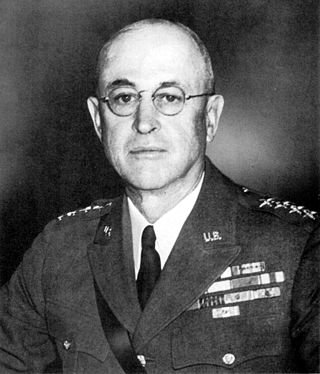
Malin Craig was a general in the United States Army who served as the 14th Chief of Staff of the United States Army from 1935 to 1939. He served in World War I and was recalled to active duty during World War II and, although he is mostly forgotten today, he played a very large role in preparing the U.S. Army for World War II.

Nelson D. Cole (1833–1899), was a United States army officer, businessman, and politician from Rhinebeck, New York.

Herbert Ball Crosby was a career officer in the United States Army. A veteran of the Spanish–American War and World War I, he attained the rank of major general as the Army's Chief of Cavalry.




















